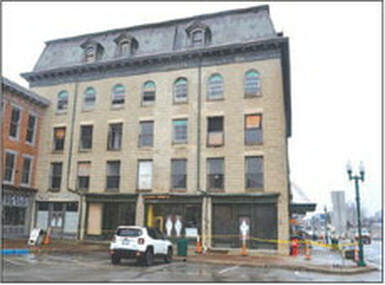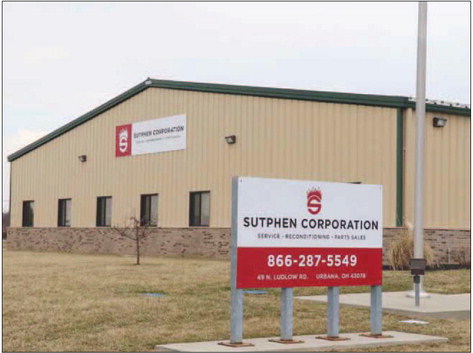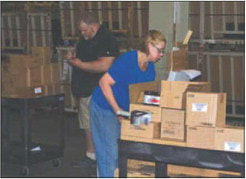While estimates show that both counties experienced declining populations over the last several years, the worst may be coming to an end, Bill LaFayette, an economist and owner of Regionomics, a Columbus-based economics and workforce consulting firm said.
The estimated population for Clark County in 2018 was 134,585, down slightly from 134,649 in 2017. In Champaign County, it was 38,754 in 2018 as compared to 38,824 in 2017. “When you look at the chart, the big story is this,” LaFayette said. “Although Clark County is losing population, it’s losing population at a slower rate than it once was.” LaFayette is right — and the same statement rings true for Champaign County as well Between 2015 and 2016 alone, Clark County’s estimated population dropped by more than 1,000 residents. In Champaign County, between 2010 and 2016, the county lost an estimated 1,358 residents. However, between 2016 and 2018, Clark County lost just 116 residents. Champaign only lost an estimated 70 residents during that same time period. Officials in Clark and Champaign counties and LaFayette have pointed to two things they say has slowed population declines over the last three years; jobs and cost of living. Economic development “I would guess the reason for the decline slowing is the economy,” LaFayette said. “More jobs are popping up.” Jobs are the biggest factor when it comes to why a resident moves to, or from, an area, LaFayette said. So far in 2019, the unemployment rate has continued to fall, according to data by the Ohio Department of Jobs and Family Services. The unemployment rate dropped to 4.1 percent in Clark County in March, down 1.3 percent since the start of the year. In Champaign, it has dropped 1.1 percent for the year, finishing at 3.4 percent in March. Melanie Flax Wilt, Clark County commissioner, said within the last couple of years, Clark County has turned its attention to workforce development. “Workforce development is huge for us,” Flax Wilt said. “We’ve been focused on bringing new jobs here.” The decision to focus more on economic development is bolstered by a 2018 labor market analysis conducted by the University of Cincinnati Economic Center in collaboration with the Chamber of Greater Springfield. The analysis found about 54 percent of residents in Clark County travel to neighboring counties for work. About 20 percent of residents surveyed for the study told researchers they travel to other counties because they don’t believe jobs are available in Clark County in their industry. Around 44 percent of those surveyed cited better wages in other counties. Flax Wilt said people in Clark County have come together over the course of the last couple of years. “It’s an exciting time in Clark County. I see it everywhere I go. I believe people recognize that we are trying to make positive changes,” Flax Wilt said. “People recognize that this county has a lot to offer.” Cost of living Bryan Heck, Springfield city manager, said living in Clark County allows people to “see their dollar going further.” “I think it’s an attractive area to them,” Heck said. “We’ve worked to bring additional jobs and that helps, of course, but the cost of living is also low compared to other regions.” Steven Hess, Champaign County Commissioner, agrees. “Whether it’s a lower cost of living or a job, it doesn’t matter,” Hess said. “Whatever gets people here.” A low cost of living is what brought Gerard Milewski and his family to Springfield. Milewski said he, his wife and their two children, ages 3 and 10, moved to Springfield in 2017 from Cincinnati. “Being able to buy a home for cheap was a huge selling point,” Milewski said. Because of low cost of living, Milewski said he doesn’t see the population decline as a bad thing. “The population decline doesn’t bother me,” Milewski said. “I think it encourages people to move to the community, people like me, to move here and put money into a home.” Homes in Clark and Champaign counties sold quicker in 2018 than in 2017, according to statistics gathered by Western Regional Information Systems & Technology, an Ohio-based company that monitors real estate trends, including in Clark and Champaign. Data from WRIST shows that 364 homes were sold last year in Clark County, up 23 from 2017, and 380 homes were sold in Champaign, up 15 from 2017. It was a transition settling into a smaller community, Milewski said, but since then his family has enjoyed living in Springfield. “The city has potential,” Milewski said. “I’ve seen smaller communities, like Springfield, in Cincinnati turn into big cities, and I think the city and the county do a good job of focusing on local issues.” Because Clark County is a smaller county, Milewski said, it can allow local governments to focus on more localized issues. “In Cincinnati, the city government is focused on major league sports teams, stuff like that, which in the long run doesn’t really affect every day people,” Milewski said. “Here, the county — local government — they are focused on small businesses and how to improve life for the average person.” Marcia Bailey, Director of the Champaign Economic Partnership, said counties across Ohio, like Clark and Champaign counties, should focus on marketing themselves to, “the average person.” “We need to make certain we are marketing ourselves to attract and increase our population,” Bailey said. In marketing themselves, counties should play on their strengths, Bailey said. “The lifestyle, career choices, new schools, growing up here and now retiring, wanting to live in a more relaxed community with a lower cost of living,” Bailey said. “I see a positive indication in our population that we are building on things like that.” It tells ‘more about your community’ While there are theories as to why the population in Clark and Champaign counties might be leveling off, more concrete answers probably won’t be available until late 2020, when results of the national decennial census will be released. Although the U.S. Census Bureau carries out hundreds of surveys every year, like population estimates, its most well known duty is still to conduct the decennial census. According to the Census Bureau’s website, a decennial census: determines the distribution of Congressional seats; makes planning decisions about community services such as where to build new roads and how to distribute more than $675 billion in federal funds to local and state governments; and provides age information for social security and other retirement benefits. “It controls a lot,” LaFayette said. It also allows people to better understand their communities, LaFayette said. “The census can tell you the characteristics of the population, earnings, education level, age distribution, whether or not people have been working, where people have been working,” LaFayette said. That’s why, he said, it’s important for residents to participate in the count taken every 10 years. “It tells you more about your community than anything else,” LaFayette said. Contact this reporter at 937-328-0329 or email Riley.Newton@coxinc.com. CLARK, CHAMPAIGN POPULATION ESTIMATES COMPARED TO 10 YEARS AGO 139,404 Clark County estimated population in 2008 134,585 Clark County estimated population in 2018 40,263 Champaign County estimated population in 2008 38,754 Champaign County estimated population in 2018 SOURCE: U.S. CENSUS BUREAU COMMITTED COVERAGE The Springfield News- Sun is committed to covering economic growth in Clark and Champaign counties.
0 Comments
By Christopher Selmek, Urbana Daily Citizen, cselmek@aimmediamidwest.com
Developers are hopeful that the former Q3 JMC Inc. property at 605 Miami St. will be ready to use later this year, with nearly three-quarters of the Johnson Manufacturing building already leased to various companies, according to True Inspection Services Vice President Joe Timm. Urbana-based TIS is just one company looking forward to taking up residence in the 32,000-square-foot building while continuing to direct the remediation of the 20-acre site. “Right now we have a contractor that’s doing most of the work and finishing up the remediation,” Timm said in February. “That should be done probably in the next 90 days, and then at that point we’ll apply for the covenant not to sue with the (Environmental Protection Agency), which will probably take another 60-90 days. Once we get that, then at that point we can start some of the redevelopment of the actual building itself.” TIS currently maintains offices at 871 S. Main St., the old Buckles Building, but plans to move to the Johnson Building later this summer. A door manufacturer from Kentucky also plans to establish warehouse space there, which Timm says will create a handful of local jobs. “We’ve had at least three people go in that building,” said Champaign Economic Partnership Director Marcia Bailey. “Right now you look at it and it looks ugly because it’s got the metal skin on it, but you get in that building and it’s gorgeous. It’s got the big brick in it and the beams, and it’s a gorgeous building.” Five acres at the rear of the property have never been built on. At the west side, the CEP is looking at a potential opportunity to clean up Ann Street and Beech Street, depending on the end user and if the city wants to maintain them. The entire property is zoned manufacturing, and Bailey said her plan is to market it as such and eventually get every inch possible utilized as manufacturing space. The east side of the property will belong to TIS, which the company will continue to redevelop and for which lessees will be sought. “All in total it’s about 20 acres of manufacturing that’s sitting there in the heart of Urbana on a US highway, so it’s prime location,” Bailey said. “Then we were trying to find someone who would honestly take the risk and the task on to help us get it cleaned up, and that’s when Joe contacted us to see what’s going on and how he might be able to help.” History The Q3 JMC property has not been fully utilized since the company ceased manufacturing operations there in 2008. The city of Urbana officially took ownership of the property in May 2017 through a tax foreclosure process and shortly thereafter obtained a $883,947 grant through a JobsOhio Redevelopment Pilot Program to perform demolition, environmental remediation, asbestos abatement, removal and disposal of waste and site preparation. “Historically it was a manufacturing operation, Q3 Stamp Metal, which had purchased the Johnson Manufacturing Company, so they called it Q3 JMC,” said Community Development Manager Doug Crabill. “It basically became an abandoned property, the taxes accumulated, and suffered quite a bit of vandalism. Then we had a fire caused by arson that destroyed part of the remaining buildings on Miami. Part of the site was under findings and orders with the Ohio EPA, so we got those findings and orders released, but part of getting those released is to complete the cleanup work that’s being done.” Honeywell International Inc. recently completed remediation of groundwater contamination in a four-acre section on the west side of the property. Honeywell became liable for the former Grimes Aerospace Plastic Research Products contamination when it acquired the Grimes company. “Honeywell’s scope was limited to VOC (Volatile Organic Compound) remediation,” said Crabill. “That was what they agreed to participate and assist with as far as that part of the cleanup and that was isolated to a small area in the back of the site. They essentially removed quite a bit of soil and had it hauled away and put back-fill in, and then they’ve installed monitoring wells. What they are trying to demonstrate is that they’ve cleaned up the source of the VOC contamination, so therefore then the groundwater is clean in that area again.” TIS also removed an 800-gallon diesel storage tank and, according to Crabill, the city received a letter from the Bureau of Underground Storage Tank Regulations that no further action is needed in that area of the property. TIS recently completed asbestos remediation work in the Johnson building. According to Crabill, the presence of asbestos was a major reason that several of the structures were not kept, along with damage from a 2015 fire ruled an act of arson by the state Fire Marshal’s Office. “The structures that were not kept were in a state that they just couldn’t be put back,” he said. “A good period had passed since the time they closed until the time we were able to take ownership of the site, and I think all of the roofs were at the end of their useful life even back when they were in business, so by the time we got in a lot of the water damage had already set in on a lot of the structures.” Partnership Bailey stated her appreciation for TIS doing their due diligence to oversee the project, adding that they would not hand the property over to a buyer until they were certain there were no longer any hazards involved. “It is a true partnership because all of the entities had responsibilities,” she said. “The city does, Honeywell had their responsibility, and at the end of the day, then, the responsibility is on True Inspection to be able to get it cleaned up and ready for the city to apply for the VAP agreement - Voluntary Action Plan - and then we start marketing. We’re already marketing, Joe and I have already had more than one person down there looking at that space.” “The Ohio EPA has a Voluntary Action Program - VAP - and essentially it’s a program where a volunteer steps up and is willing to bring a property up to a certain environmental standard that Ohio EPA has developed,” said Crabill. “They have a certified professional that oversees that, the city has one of those who oversees this, and he prepares all the documentation of all the remediation that’s been done and certifies that the site is clean under rules of the VAP. As a result of that, there is a covenant not to sue that’s issued by Ohio EPA as a result of all the work that’s been done to clean up the site. It’s a good tool for property redevelopment so that sites like this don’t sit idle because they can’t be cleaned up.” “We’re excited at the opportunity,” said Timm. “We’ve made good progress, and it’s taken a little longer than we anticipated, but with any time there’s environmental cleanup there’s unforeseen items that come up. But we’re making good progress and we anticipate getting a covenant not to sue this summer, starting renovation in the fall, and having people moved in and have some new jobs created by the end of the year, start of next year.” The property is currently divided into about 26 parcels which Bailey said will need to be consolidated before they can be sold. Bailey said she hopes to have a buyer within six months; anyone interested may contact the CEP at (937) 653-7200.
Key development projects
Thanks to economic development investments by private businesses working with the CEP, Urbana – for the first time ever – ranked 41st in the Site Selection magazine’s 2017 list of top U.S. micropolitan communities. Recent successes include the new Navistar distribution center, Memorial Health’s medical building, expansion of Weidmann Electrical Technology, opening of Nutrien Ag Solutions, Sutphen Corporation’s new Service, Parts and Refurbishment Center, expansion of Old Souls Farms hydroponic operations, expansion of Advanced Technology Products and purchase of the former Robert Rothschild Farm property. Champaign County manufacturing jobs have grown from under 3,000 jobs in 2013 to nearly 4,000 in 2018. Major projects for 2019 include:
The CEP is partnering with schools and businesses in numerous ways to help make sure Champaign County has the skilled workforce required by new and expanding businesses. Results of these partnerships include:
Future development
For more information, call the CEP at 937-653-7200 or browse CEPOhio.com.
Makes good use of vacant building
Employers in Clark & Champaign counties have jobs to fill now
Amy Donahoe, director of Workforce Development with the Chamber of Greater Springfield, said the falling unemployment rate is an example of Clark County continuing to see businesses hire and grow.
“We are seeing individuals becoming employed right away when businesses are hiring,” Donahoe said. “There is no reason for people not be working right now.” Donahoe said the Chamber is focusing to tap into the workforce within Clark County to keep residents working close to home. “We have a lot of people living here but working outside of the area,” Donahoe said. “We are working on keeping people here and helping people find work closer to home.” Bill LaFayette, an economist and owner of Regionomics, a Columbus-based economics and workforce consulting firm, said the unemployment rate for Clark County is good. LaFayette said that Ohio DJFS does not seasonally adjust, or account for seasonal patterns that include summer hiring, major holiday hiring and school schedules. State and national figures are adjusted for those factors. Statewide, Ohio’s unemployment rate dipped slightly to 4.4 percent, down 0.2 percent from February, according to the OJFS. The nationwide unemployment rate remained steady at 3.8 percent, continuing its downward trend. “If we are looking at seasonally adjusted numbers, unemployment still went down from 4.2 in February, to 4 in March,” LaFayette said about Clark County’s unemployment numbers. In Champaign County, the unemployment rate was 3.4 percent in March, down from 3.8 percent in February. Marcia Bailey, director of the Champaign Economic Partnership, said the county’s unemployment numbers are, “great news.” “These numbers are great, but there is a flip side to this story,” Bailey said. “The other side is that there are still jobs that need to be filled and companies that are hiring right now.” Companies across Champaign County are looking to fill positions right now, Bailey said. “We want people to understand that there are jobs available and we encourage them to come and see us,” Bailey said. “We want to help everyone find their career.” Contact this reporter at 937- 328-0329 or email Riley. Newton@coxinc.com. MORE DETAILS CLARK COUNTY March: 4.1 percent February: 4.6 percent January: 5.4 percent CHAMPAIGN COUNTY March: 3.4 percent February: 3.8 percent January: 4.5 percent By Kathy Fox, Urbana Daily Citizen, kfox@aimmediamidwest.com
Representatives of Parker Trutec, on Upper Valley Pike, and Rosewood Machine & Tool Co., on Kiser Lake Road, said Honda’s plan to idle a second-shift production line at the Marysville assembly plant, as it slows production of Accords, may have little impact on their businesses. Honda has said buyers’ interest in SUVs and small trucks is rising and interest in small cars is declining, hence the slowdown of the production line, which is to begin in August and may last a few years. “The impact depends on the duration,” said Jeff Helman, a vice president of the Rosewood business. Both local businesses manufacture products for Honda, but not only for its Accord line, and both businesses manufacture products for customers besides Honda. “We do a lot of service parts for Honda not tied in with production lines,” said Brian Beatty, Parker Trutec plant manager. “We are unclear at this point,” he said of potential impact to his plant. “We need to research to see about the impact.” He added, “Business is good otherwise.” Beatty said he expects any impact to be minor for the plant, which has about 180 workers. About 95% of Parker Trutec’s business is automotive, with orders coming from Honda as well as other vehicle manufacturers. “It can have an impact, but it’s not unprecedented,” Helman said. “They make these kinds of adjustments from time to time … “It’s no secret Accord sales are down … the public wants these little crossover SUVs. “Honda’s been adept at changing tooling,” he added. “Their lines are designed to change to other models.” He said the Rosewood business is a Honda supplier for tooling and equipment. “We make parts to make the cars. “Honda’s been a very good customer, a good partner for us,” Helman said, adding that the local business manufactures products for Honda facilities besides its Marysville plant, as well as for businesses other than the automotive industry. “Our objective has always been to be diversified,” he said, adding the company, which employs about 40 people, manufactures products for various types of customers, including those in the HVAC and food-processing industries. “Honda has a huge impact on this area of the state,” Helman said. Noting that companies across the state manufacture products for Honda, he said it could take time for any impact to materialize. “It’s not time to panic. It’s time to adjust to changes in the market,” he said, adding he thinks Honda has such a plan. Honda has said there will be no layoffs, although voluntary buyouts will be offered. Helman said if jobs are affected, people will find a “positive job market.” “We’re all dealing with people shortages,” he said. “There are jobs out there. If we could find the right people, we could use a couple people.” Although messages left at Honda supplier KTH Parts Industries Inc. were not returned, a June 2016 article in the Daily Citizen quotes a KTH spokesperson as noting consumers’ growing interest in SUVs over smaller vehicles and saying KTH, located on state Route 235, was making changes to adjust to this shift in interest. Kathy Fox can be reached at 937-652-1331, ext. 1773.
Workforce development is a major focus of the CEP, she said. Following are examples of how the CEP and its partners are strengthening the local workforce:
Business Liaison Ashley Cook, who teaches Ohio Hi-Point Career Center’s Supply Chain Management program at Urbana High School, coordinates activities that bring schools, students and businesses together throughout Champaign County. This includes job fairs, in-school presentations by businesses and spreading the word about internships, job shadowing opportunities and job openings. Nancee Starkey, human resources generalist at Bundy Baking Solutions, said that Cook helped her set up presentations at Graham, Urbana and Triad high schools. She added that a few Graham seniors are working second shift at Bundy while they finish their studies.
Ruhe added that Triad High School graduate Zack Zizzo, who was in the Ohio Hi-Point Advanced Manufacturing program, is now working at Orbis as a paid intern while he completes the two-year mechanical engineering technology program at Clark State Community College – with tuition assistance from Orbis. He will continue working at Orbis after he graduates in June. Ruhe said that Orbis met Zizzo at a local Manufacturing Day event where he presented a 3D printing project he worked on at Triad.
Also, Urbana University is working with employers to:
|
Archives
February 2024
Categories
All
|
|
CEP Office Location:
40 Monument Square, Suite 306 Urbana, Ohio 43078 937-653-7200 |
All drone photography courtesy of Jassen Dobyns of UAVisions LLC. Additional photography courtesy of Dave Millner of the Champaign Camera Group.
Website by Berry Digital Solutions, LLC Urbana, Ohio |
Click on the logos for more information.











 RSS Feed
RSS Feed










